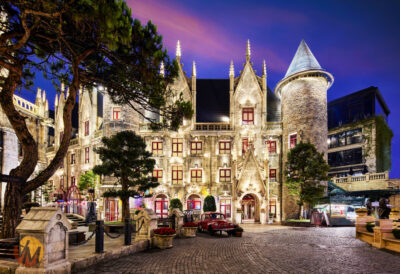My Son Sanctuary, a UNESCO World Heritage site located in a lush valley in Central Vietnam, is the most significant remnant of the ancient Champa Kingdom. This sprawling archaeological complex features dozens of red-brick temple towers dedicated primarily to the Hindu deity Shiva, showcasing a unique architectural and sculptural style with deep connections to the Indian subcontinent. For visitors, it offers a profound journey into a lost civilization and a crucial piece of Southeast Asian history. This guide provides a comprehensive overview of the site’s history, what to see, and practical tips for a meaningful visit.
As your Vietnamese guide, this is one of the most special places Vietnamstory.in can share with our visitors from India. Here, in the heart of ourda country, you will find a beautiful and ancient connection to your own culture. You will see the familiar and beloved form of Lord Shiva, of Ganesha, and hear the stories of a kingdom that was deeply influenced by the great traditions of India. So, let’s journey back in time together.
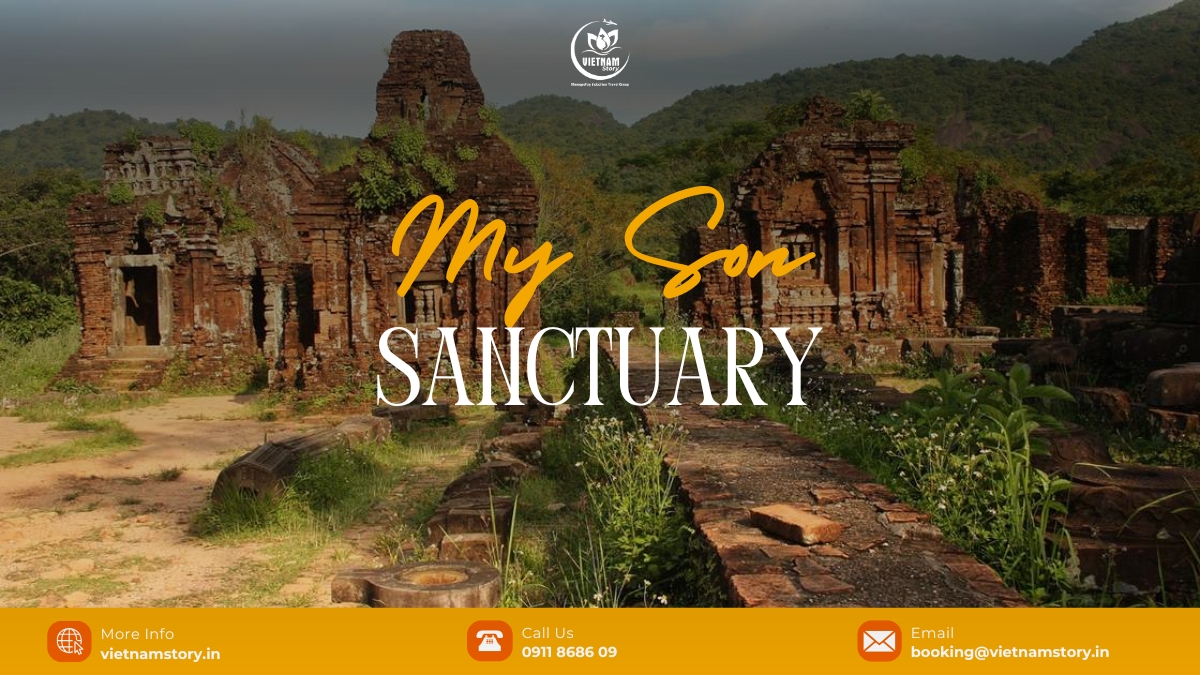
My Son Sanctuary: 3 Essential Facts (Price, Hours, Location) You Should Know
- Location: My Son Sanctuary is located in Duy Xuyen District, Quang Nam Province, about 45 km from Hoi An and 69 km from Da Nang.
- Entrance Fee: The ticket costs 150,000 VND (approximately ₹500 INR), which includes an electric shuttle ride and a Cham dance performance.
- Best Time to Visit: Join a Sunrise Tour (early morning) or visit in the late afternoon to avoid the midday heat between 11 AM – 2 PM.
Who were the Champa people? A brief history
To understand My Son, you must first know about the incredible Champa Kingdom. They were a powerful and artistic civilization that ruled over Central Vietnam for over a thousand years, from around the 4th to the 13th centuries. They were a seafaring people, and through their trade routes, they came into close contact with India.
From India, they embraced many things, but most importantly, they embraced Hinduism, with Lord Shiva as their primary deity. My Son Sanctuary became the most important spiritual and political center of their entire kingdom. It was here that their kings were crowned and buried, and where they built magnificent temples to honor their gods.
The Cham civilization’s adoption of Hinduism – particularly the worship of Lord Shiva – reveals a deep historical connection with the religious traditions of the Indian subcontinent. For our travelers, especially those from Chennai and the Tamil Nadu region, a land rich with ancient Shiva temples, this link is unmistakable. The style of worship and the focus on powerful deities here reflect the enduring spiritual practices of South India, making My Son Sanctuary a truly unique cultural bridge.
What to see at My Son Sanctuary?
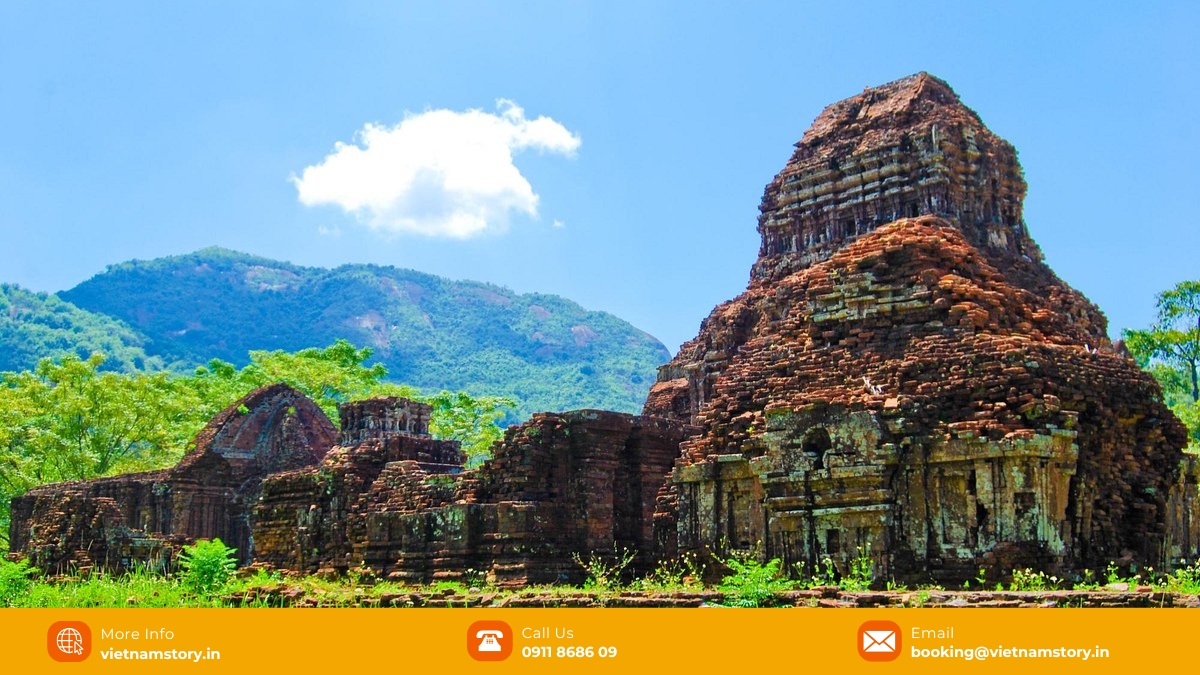
When you visit My Son, you are not visiting one single temple. You are exploring the ruins of a once-great city of temples, nestled in a beautiful, green valley surrounded by mountains. The site is divided into several different “groups” of temples, labeled with letters like A, B, C, D.
The Red Brick Towers
The main feature of My Son is its beautiful, intricate red-brick towers that showcase the remarkable craftsmanship of the Cham people. Even today, their construction techniques remain a mystery to scientists. The towers were built from baked bricks that were carved after firing and stacked together without the use of mortar, yet they have stood strong for centuries. This unique method stands as a one-of-a-kind testament to the architectural genius of the Champa civilization.
The Carvings of the Gods
As you walk around, look closely at the beautiful sandstone carvings. You will see many familiar figures. There are incredible depictions of Lord Shiva, as well as Ganesha, Vishnu, and many beautiful Apsaras (heavenly dancers). The style is unique to the Cham people, but the spirit is one that you will recognize instantly.
The Lingam and Yoni
At the heart of most of the main temples, you will find a Lingam-Yoni altar, the symbol of Shiva and the creative forces of the universe. It is a powerful reminder of the deep Hindu roots of this sacred place.
The Bomb Crater
As your friend, we must also show you the sadder parts of our history. During the Vietnam War, this beautiful, sacred valley was heavily bombed. You will see giant bomb craters right next to the ancient temples. It is a powerful and sobering reminder of how close we came to losing this precious piece of world heritage forever.
Kate festival
If your trip falls in early October, you’ll have the chance to witness the Kate Festival – the most important celebration of the modern Cham community. This festival honors the ancestors and offers a direct connection to Cham heritage. Vietnam Story recommends checking the exact event schedule when planning your visit.
Imagine the ancient, silent ruins of My Son suddenly coming alive with vibrant colour, music, and dance! During the Kate festival, the Cham people gather here to honor their gods and their ancestors. You will see them in their stunning, colourful traditional clothing, and the air will be filled with the beautiful, symphonic sounds of their traditional music. It is a time for them to share their joy, pray for good fortune, and connect with their ancient heritage. To witness this passionate and miraculous festival is like being given a secret window back in time, a chance to feel the living, breathing soul of the Cham culture in its most sacred place. It is an absolutely unforgettable experience.
What to eat near My Son Sanctuary?

After a few hours of walking through the ancient ruins, we know you will be feeling hungry and thirsty! While there are a few very simple drink stalls right at the entrance to My Son Vietnamstory.in wants to give you our honest advice: the best and most authentic food is found in the small towns and villages you will pass through on your way back towards Hoi An or Da Nang.
Here are a few delicious local specialties from our Quang Nam province that you absolutely must try:
- Quang noodle (mi Quang)
- Cau Mong smoked calf (Be thui Cau Mong): Cau Mong Grilled Veal is a specialty dish made from tender young veal, roasted to perfection. For Indian travelers, Vietnam Story recommends considering beef-free dishes such as Mi Quang (a signature noodle dish) or Banh Xeo (Vietnamese crispy pancake) to better align with Hindu dietary preferences.
- Phu Chiem noodle (mi Phu Chiem)
- Vietnamese pancake (Banh xeo)
- Rice cracker (Banh trang dap)
Practical information for your visit
Location
- Address: Duy Phu Commune, Duy Xuyen District, Quang Nam Province
Imagine a beautiful, lush green valley, completely surrounded by quiet hills and mountains. Nestled within this hidden valley, you will find the ancient and mysterious ruins of My Son Sanctuary. This was once a great city of beautiful Cham temples, spreading for over two kilometers
How to get there?
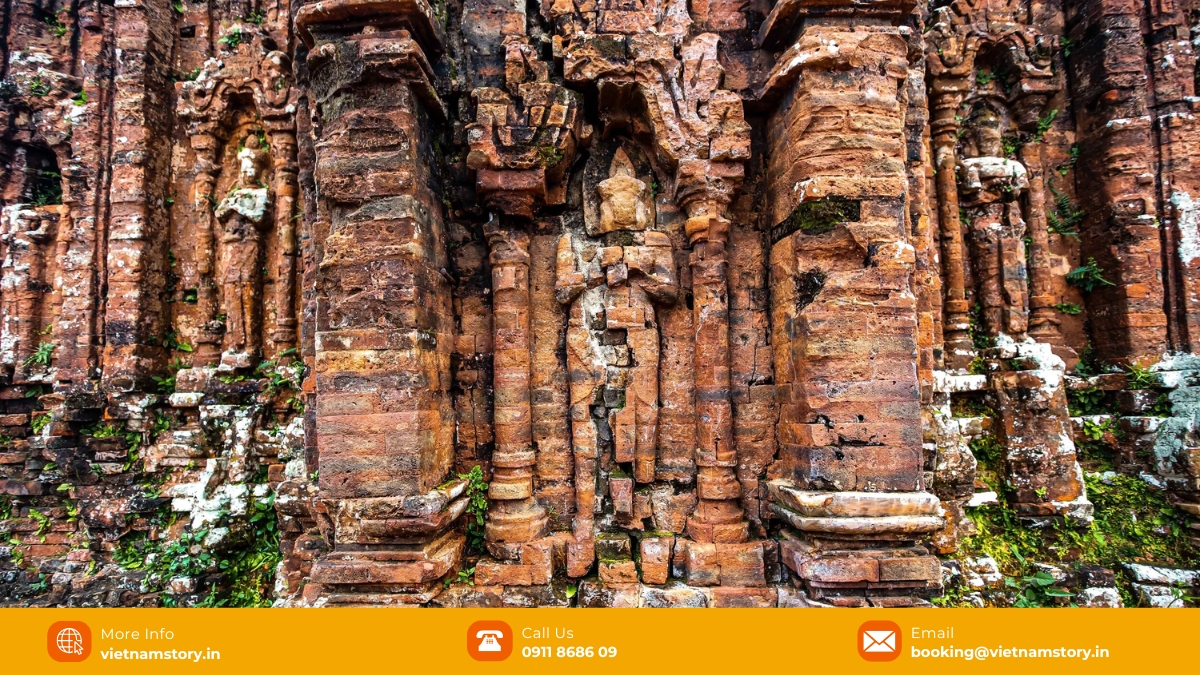
My Son is located about 45 kilometers from Hoi An and 69 kilometers from Da Nang.
- Joining a tour: This is the most popular and recommended option. A good tour will include your transport, your entrance ticket, and, most importantly, a knowledgeable guide who can explain the history and the meaning of what you are seeing.
- From Hoi An: Getting to the beautiful My Son Sanctuary from the charming town of Hoi An is very simple. Here are the best ways to make the journey:
- By motorbike (For the adventurous): If you are a confident and experienced rider, a scooter is a fantastic way to go. The drive takes about one hour through our beautiful, green countryside. The route is quite straightforward, and you will see signs pointing you towards My Son. It’s a lovely way to see a bit of rural Vietnam on your own.
- By shuttle bus (The smart and budget-friendly choice): For a very easy and affordable option, Vietnamstory.in highly recommend booking a seat on one of the tourist shuttle buses. They pick you up from a central point in Hoi An in the morning and bring you back in the afternoon. It’s incredibly cheap and completely hassle-free, though you will still need to buy your own entrance ticket when you arrive.
- By private car or as part of a tour (The best overall experience): For families, or for anyone who wants the most comfortable and enriching experience, hiring a private car or, even better, joining a guided tour is the best choice. A tour is fantastic because it not only includes your transport but also a knowledgeable guide who can bring the ancient ruins to life with their stories. This is the option we always recommend to get the most out of your visit.
- From Da Nang: If you are staying in the beautiful city of Da Nang, getting to My Son Sanctuary is also very easy. The journey is a bit longer than from Hoi An, usually taking about an hour to an hour and a half. Here are your best options:
- By motorbike or car (The scenic route): For those who are adventurous, a scooter or a private car is a great way to go. You’ll drive south from Da Nang, and the route will take you through some lovely countryside scenery. You don’t need to worry about all the different road numbers; your Google Maps will guide you there perfectly, and there are signs to help you as you get closer.
- By bus (The local adventure): For a truly local and super budget-friendly experience, you can take the local bus (number 06) from Da Nang to My Son. It’s very cheap, Vietnamstory.in must be honest with you: it will take a bit longer, and the bus stop is not right at the entrance, so you will have a little walk.
- By joining a tour (The easiest and most recommended way): Honestly, the best and most popular way to visit from Da Nang is to join a guided tour. This takes away all the stress of navigation. Your transport is arranged for you, and most importantly, you will have a wonderful guide who can explain the fascinating history of the ruins. This is how you will get the richest and most meaningful experience.
Entrance fee and opening hours
The site is open daily from 6:30 AM to 5:30 PM. The entrance fee is 150,000 VND per person (approx. ₹500 INR), which includes the electric buggy ride to the main temple site.
The Apsara Dance Performance
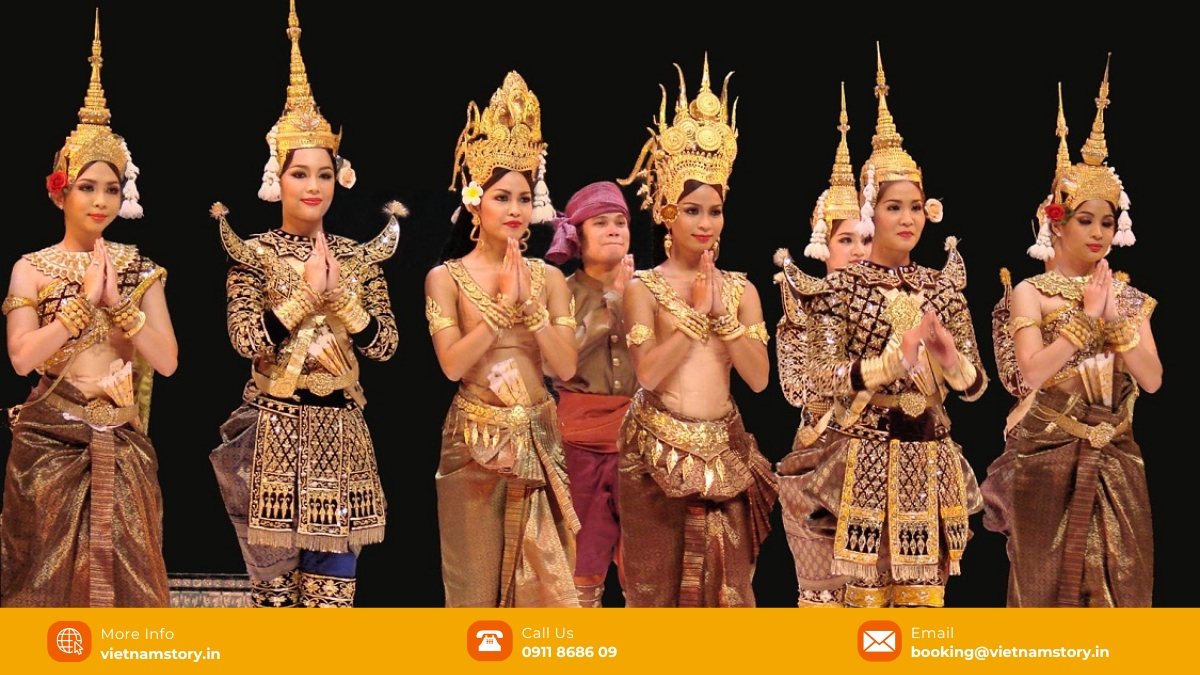
Don’t miss this! Several times a day, there is a beautiful, traditional Cham dance performance near the entrance. It’s a wonderful way to see the ancient culture come to life. Check the schedule when you arrive.
Essential tips for a perfect visit
- Go early or late! This is my most important tip. The valley can get incredibly hot in the middle of the day. The absolute best times to visit are early in the morning (to see the ruins in the soft light and cool air) or late in the afternoon (for the beautiful golden light). Please try to avoid visiting between 11 AM and 2 PM.
- All-Inclusive Tour: The Best Choice for Indian Travelers: Vietnam Story highly recommends choosing an All-Inclusive Tour with a professional guide. The benefits go far beyond convenient transportation — it’s about the rich historical and cultural insights our guides bring to life. Without a guide, you might find yourself simply looking at old bricks, missing the deeper story they tell.
- A guide is essential: I truly believe that to appreciate My Son, you need a guide. Without a guide, you are just looking at old bricks. With a guide, those bricks come alive with stories of kings, gods, and a lost civilization.
- Wear comfortable shoes and dress respectfully: You will be doing a lot of walking on uneven ground, so sturdy shoes are a must. As this is a sacred site, please be respectful and make sure your shoulders and knees are covered.
- Bring water, a hat, and sunscreen: The sun is strong, and there is not a lot of shade among the ruins themselves. Be prepared!
Conclusion
A visit to My Son Sanctuary is a profound and unforgettable journey. It is a chance to walk through the pages of a history book and to stand in a place of great spiritual power. For our visitors from India, it is something even more special. It is a beautiful, tangible link between our two cultures, a testament to a time when our ancestors shared stories, art, and a deep reverence for the divine. It is a powerful reminder that we are all connected.
A visit to My Son Sanctuary is living proof of the deep spiritual connection between Vietnam and India – a reminder that we share a common historical heritage.
But don’t stop at simply admiring these ancient ruins! Let Vietnam Story – a specialized brand under the Indochina Travel Group – craft a meaningful and complete journey for you. We are dedicated to offering Tailor-Made
Experiences and Local Expertise, designed with deep respect for Indian travelers’ cultural preferences.
Start your journey today:
- Hotline: +84 911 868 609
- Email: booking@vietnamstory.in
Let us turn the pages of history into your most unforgettable adventure.

